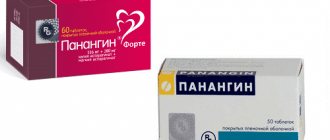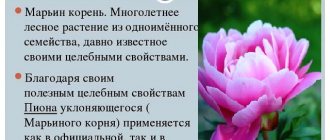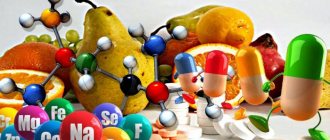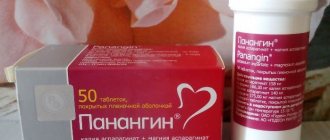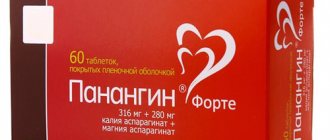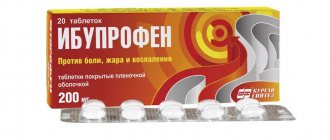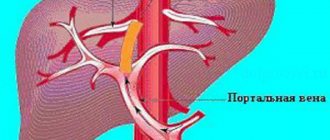0
Author of the article: Marina Dmitrievna
2017.11.04
1 938
Drugs
Panangin is a combination drug consisting of potassium and magnesium aspartate. The components of the drug are essential macroelements in the human body. Magnesium and potassium are involved in neuromuscular, neuroendocrine, metabolic processes and in the regulation of the renin-angiotensin-aldosterone system.
Panangin
Panangin increases or decreases blood pressure
Practicing doctors strongly recommend taking this drug not only to heart patients, but also to practically healthy people - in order to quickly eliminate the deficiency in the molar concentration of the elements potassium and magnesium.
But still, the vast majority of patients often wonder whether Panangin increases or decreases SBP and DBP. So, in order to answer it, it is necessary to understand the individual features of the implementation of the clinical effect. So, the deficiency of potassium and magnesium, which Panangin’s action is aimed at eliminating, manifests itself in a violation of the frequency, as well as the sequence of heart contractions - in other words, a rather severe arrhythmia develops, which leads to serious hemodynamic disturbances. It is logical to assume that all this becomes the reason that significant jumps in blood pressure and other clinical manifestations of hemodynamic instability occur.
And due to the fact that after taking Panangin, the heart rate becomes much more stable, the blood begins to move normally through the vessels (its rheovasographic indicators are normalized), and blood clots and cholesterol lose their chance of blocking the vascular lumens.
The composition of Panangin makes it possible to take it both to optimize cardiac activity and to normalize metabolism, prevent the aging process and wear of myocardial tissue, as well as for further prevention of atherosclerosis, ischemia, arrhythmia
Yes, and with high blood pressure, you can also take these pills - even if it does not normalize these indicators, normalization of hemodynamic processes will have a positive effect on the general condition of the cardiovascular system, which is very important for stabilizing the general condition of a person
But some experts in the field of cardiology and therapy unanimously argue that with essential hypertension it is clearly necessary to adjust the treatment regimen so that this medication does not provoke a sharp drop in blood pressure in complex therapy.
Side effects
Panangin's ability to reduce blood pressure is one of the side effects of the drug. Hypotonic patients should exercise caution when taking it.
Individual reactions to the drug may occur:
- diarrhea;
- nausea accompanied by a gag reflex;
- dry mouth;
- allergic itching, skin rash;
- convulsions.
Important! Violating the rules for taking the drug may increase the likelihood of unpleasant side effects. It is not recommended to independently increase the dosage of Panangin prescribed by a doctor, so as not to cause a state of hyperkalemia or hypermagnesemia.
Adverse reactions and overdose
Enter your pressure
130
on
90
Search in progress Not found
To avoid any unwanted effects after taking the medicine, you should strictly follow the instructions and prescriptions of your doctor.
In some cases, when taking the drug, the following occurs:
- partial decrease in reflexes;
- convulsions appear;
- an allergic reaction occurs due to skin irritation.
There may be vomiting, nausea, fever, upset stool, discomfort in the pancreas area, and slow reactions. One of the adverse reactions is a decrease in blood pressure. Therefore, uncontrolled use of the drug at low blood pressure is prohibited.
Often patients taking Panangin noted nausea, fever, discomfort and burning in the pancreas
The development of excess potassium and magnesium in the patient’s body cannot be ruled out. There have been no officially reported cases of overdose with this drug. But theoretically such a possibility exists. In such a situation, you should stop taking the pills and seek help from a healthcare professional.
Potassium and magnesium deficiency
If there is a lack of potassium and magnesium in the body, their place is taken by physiological antagonists - sodium and calcium. Sodium brings water into the heart muscle cells, resulting in edema, which reduces the performance of the heart. The organ contracts worse, the rhythm is disturbed. Calcium causes myocardial spasm and prevents it from relaxing. Metabolic processes worsen, as blood enters the heart muscle, bringing with it nutrients and oxygen, only during the period of its relaxation.
Panangin increases or decreases blood pressure
Arterial hypertension can often be triggered by insufficient magnesium in the body. This mineral is greatly consumed during stress and physical activity. If this deficiency is eliminated, Panangin lowers blood pressure.
To effectively combat high blood pressure, medications with a diuretic effect are needed. But along with the fluid, potassium is also removed from the body. To compensate for the deficiency, medications containing potassium are prescribed. In this case, Panangin is prescribed for high blood pressure to normalize the electrolyte balance. Does Panangin lower blood pressure or not? All hypertensive patients who are prescribed diuretics to lower blood pressure must be prescribed this drug to compensate for potassium deficiency.
When drawing up a treatment regimen, it should be taken into account that for people taking ACE inhibitors and potassium-sparing diuretics, only a doctor prescribes the medicine. You should strictly adhere to the dosage indicated by your doctor so as not to provoke an excess of potassium, since the listed drugs retain potassium in the body.
How does Panangin affect high blood pressure, it becomes clear that it reduces it
"Panangin" is contraindicated for low blood pressure. Hypotonic patients should be very careful.
In case of individual intolerance, the following negative manifestations are possible:
- dry mouth;
- allergy;
- diarrhea;
- muscle spasm;
- nausea.
If the treatment regimen is not followed, the likelihood of negative consequences increases. Self-medication can provoke hypermagnesemia and hyperkalemia.
The drug is not recommended for use if:
- myasthenia gravis;
- kidney failure;
- individual intolerance;
- hemolysis;
- AV blockade of the third degree;
- pathological condition of the adrenal glands;
- dehydration.
Using a medication not according to instructions significantly increases the risk of developing side symptoms.
As a last resort, on the recommendation of a doctor, the drug is prescribed during pregnancy and breastfeeding. Does Panangin increase blood pressure? No, it normalizes blood pressure, so its use is limited for hypotensive patients. For hypertension, the treatment regimen should be adjusted so that the medication does not provoke a sharp decrease in blood pressure.
How is Panangin and blood pressure related? It reduces its levels, provides the body with magnesium and potassium. Uncontrolled use of the medicine may have negative consequences.
Action of the medicine
The drug is used in cardiology as a medicinal component of the complex treatment of cardiovascular diseases. Patients must understand that Panangin alone is not able to eliminate existing pathology. The medicine is prescribed as an adjunct that normalizes the functioning of the organ and maintains the optimal condition of the heart muscle.
Cardiologists prescribe medication to improve metabolism, disturbed as a result of magnesium and potassium deficiency. If the test results indicate hypokalemia, hypomagnesemia, the doctor decides to undergo a course of therapy with Panangin. The drug can be taken as an independent remedy only for the purpose of preventing cardiovascular diseases.
Cardiologists include medicine in therapy for diseases and disorders:
- heart rate;
- metabolism;
- intoxication;
- dehydration as a result of prolonged diarrhea;
- associated with high blood pressure.
Panangin for hypertension is taken as a complex remedy . It is included in therapy along with blood pressure-lowering drugs that are taken on an ongoing basis. Panangin is taken in courses.
The drug helps:
- with high blood pressure, Panangin normalizes vegetative-vascular activity, preventing the risk of developing myocardium and atherosclerosis;
- optimize metabolic processes;
- prevent the development of coronary heart disease;
- eliminate potassium and magnesium deficiency;
- regulate heartbeat, eliminate arrhythmia;
- strengthen the work of the heart muscle.
Panangin increases or decreases blood pressure
With constant surges in blood pressure (BP), the work of the heart is disrupted. The heart muscle is depleted. For prevention and therapy purposes, medications containing macroelements are needed. They prevent the development of arrhythmia and angina. Such drugs include Panangin. It is prescribed not only to people with blood pressure problems, but also to healthy people, to compensate for the lack of magnesium and calcium. Before you start taking Panangin, the instructions for use should be carefully studied, then it will become clear at what pressure the medication is prescribed.
"Panangin" is available in the following forms:
The main active ingredients are magnesium and potassium aspartates. They transport minerals inside cells and improve their absorption.
Additional components:
- talc;
- potato and corn starch;
- water for injections;
- titanium dioxide;
- silicon dioxide
Only ampoules are available with a doctor's prescription.
"Panangin" is produced in the form of a solution intended for injection and tablets taken orally
The drug is prescribed to replenish insufficient amounts of magnesium and potassium in the body. The medication is used for diseases of the organ system that ensures blood circulation in the body in combination with other medications.
Indications for use:
- arrhythmia caused by changes in electrolyte metabolism;
- heart failure;
- during the rehabilitation period after a heart attack.
As an additional component, the medication is prescribed:
- to remove stones from the urinary system;
- increasing stress resistance;
- athletes;
- when getting rid of alcoholism;
- for normal functioning of the gastrointestinal tract.
Therapy should be started on the recommendation of a doctor.
The drug "Panangin" contains substances that are necessary to strengthen and nourish the heart muscle
To understand whether Panangin lowers blood pressure or not, you should study the mechanism of its therapeutic effect. The main components of the medication are aimed at nourishing and strengthening the myocardium. The drug is prescribed to prevent diseases of the blood vessels and myocardium.
The drug normalizes metabolic processes. If there are insufficient amounts of magnesium and potassium ions, vital systems may fail.
Serious pathologies occur:
- blood pressure levels increase;
- atherosclerosis.
The drug prevents coronary disease and increases blood flow through the myocardial vessels. After taking the drug, the active components almost immediately enter the blood plasma and are excreted in the urine. Does Panangin reduce blood pressure? The answer is yes. The drug is prescribed to hypertensive patients.
The medication is taken after meals, as gastric juice reduces the effectiveness of the medication. The dosage is selected individually by the doctor. It depends on the patient’s condition, stage of the disease, and test results. Adult patients are prescribed up to 2 tablets 3 times a day. If necessary, at the discretion of the doctor, the dosage can be increased to 3 tablets. The maximum dosage per day is 9 tablets. During off-season periods, a course of the drug may be prescribed to compensate for the insufficient amount of minerals obtained from food. In this case, take up to 2 tablets per day.
The dosage of the drug is selected individually for each patient and depends on the diagnosis.
2 ampoules of solution for injection are administered intravenously. The next administration is acceptable after 4–6 hours. For intravenous use, take into account that 1 ampoule is diluted with 100 ml of 5% glucose solution. It should be borne in mind that only a specialist can choose the correct dosage. He will prescribe the necessary tests and also find out what other medications the patient is taking.
Compound
"Panangin" is available in the following forms:
- tablets;
- dragee;
- ampoule
The main active ingredients are magnesium and potassium aspartates. They transport minerals inside cells and improve their absorption.
Additional components:
- talc;
- potato and corn starch;
- water for injections;
- titanium dioxide;
- silicon dioxide
Only ampoules are available with a doctor's prescription.
"Panangin" is produced in the form of a solution intended for injection and tablets taken orally
Instructions for use of Panangin Method and dosage
Panangin tablets, instructions for use
How to take the medicine? The drug is taken orally three times a day, 2 tablets. Maintenance and preventive therapy: 1 tablet three times a day, course for 3-4 weeks. In some situations, a repetition of the course of therapy is required.
Instructions for intravenous use
Panangin solution is injected intravenously, slowly. The drug is administered at a rate of 20-30 drops per minute, 1-2 times a day, 300 ml. Dosing of the drug Panangin during pregnancy is carried out according to the standard regimen of medication use.
Children can take the medicine from birth.
How to take Panangin for prevention?
If you ask the question of the benefits and harms of Panangin, you should realize that this is a drug that has its own side effects, so you should not use it for prevention. Firstly, in this way you accustom the body to a high content of magnesium and potassium, and secondly, you can provoke an overabundance of these substances, which in turn can cause a lot of negative reactions.
Manifested by muscle hypotonicity, hyperkalemia, slowing of atrioventricular conduction, cardiac arrest, arrhythmia, paresthesia of the limbs, changes in the electrocardiogram. An emergency intravenous infusion of a solution of dextrose and sodium chloride is required. If necessary, peritoneal dialysis and hemodialysis are justified.
Panagin is able to enhance the negative bathmotropic and dromotropic effects of antiarrhythmic drugs. The medication eliminates hypokalemia, which develops against the background of long-term use of diuretics, glucocorticosteroids, and MCS. NSAIDs, ACE inhibitors, heparin, potassium-sparing diuretics, cyclosporine, beta-blockers increase the risk of hyperkalemia. When using general anesthetics, the inhibitory effect of panangin on the nervous system increases. Succinyl chloride, decamethonium, atracuronium, suxamethonium enhance neuromuscular blockade. The use of enveloping and astringent medications reduces the absorption of potassium and magnesium in the digestive tract. In combination with insulin, dextrose as part of a polarizing mixture, the heart rate is normalized in case of an overdose of cardiac glycosides, in case of ectopic arrhythmias, myocardial infarction. Panangin improves the tolerability of cardiac glycosides and is pharmaceutically compatible with their solutions.
Does not require a prescription.
Keep out of the reach of children at a temperature of 15-30 degrees Celsius.
Who is the drug prescribed to?
The main purpose of Panangin is to compensate for the deficiency of potassium and magnesium. It is widely used in the treatment of diseases associated with the cardiovascular system, as an additional agent in therapy:
- heart failure, angina pectoris;
- after a heart attack during the rehabilitation period;
- arrhythmia caused by disturbances in electrolyte metabolism (premature beats and pauses are noted when measuring the pulse);
- in case of poisoning with cardiac glycosides.
In addition, as a concomitant drug it is recommended:
- to increase resistance to stress;
- athletes;
- in addition to “starvation” diets;
- to normalize the functioning of the gastrointestinal tract;
- when removing stones from the kidneys;
- in the treatment of alcoholism.
Interaction with other medications
When talking to your doctor, be sure to tell them what medications you are taking.
Interaction of "Panangin" with other medications:
- increases the absorption time of iron salts and Tetracycline. You should maintain a gap of 3 hours between taking medications;
- when taking potassium-sparing diuretics and ACE inhibitors simultaneously, hyperkalemia is possible;
- the effectiveness of cardiac glycosides decreases;
- Calcitriol increases the amount of magnesium in the blood.
A competent specialist will take into account all factors when drawing up a treatment regimen.
"Panangin" has 2 analogues:
- "Asparkam." Is the most popular. It has a completely similar composition, but the price is several times lower. Reviews confirm the effectiveness of Asparkam. The only difference is in the form of release. The domestic manufacturer produces Asparkam in tablets. Since the medicine is an analogue, its therapeutic effect is slightly weaker than that of the original.
- "Aspangin." It is a complete analogue. Available in the same forms of injections and tablets. The only drawback is the less pronounced therapeutic effect compared to the original.
The decision about the need to prescribe an analogue is made by the doctor.
There are mostly positive reviews from patients about the drug. They note that after using the medication, the functioning of the heart muscle noticeably improved.
Natalia, 40 years old: “My diagnosis is hypertension. The doctor prescribed Asparkam in combination with diuretics. But the pharmacy recommended that I buy its original “Panangin”. It has a great therapeutic effect. Heart pain and shortness of breath disappeared. The only drawback of the drug is its high cost.”
Karina, 32 years old: “I have been suffering from this problem since childhood - the minerals necessary for the normal functioning of the heart are removed from the body. We have to constantly make up for their deficit. The doctor recommended Panangin. After the first week of therapy, my condition improved noticeably. Fatigue and weakness disappeared. I recommend to everyone!".
Description current as of 06/06/2014
- Latin name: Panangin
- ATX code: A12CC30
- Active ingredient: Potassium and magnesium aspartate
- Manufacturer: Gedeon Richter (Hungary)
Active ingredients: magnesium aspartate (140 mg) and potassium aspartate (158 mg).
Additional substances: silicon dioxide, corn and potato starch, talc, povidone, magnesium stearate. The shell consists of talc, macrogol 6000, titanium dioxide, methacrylic acid copolymer.
Concentrate for solution (Panangin IV)
Contains magnesium aspartate (40 mg) and potassium aspartate (45.2 mg), as well as water for injection.
Available in tablet form and as a solution concentrate.
What is the medicine for? This is a source of potassium and magnesium. The drug helps restore electrolyte balance, regulates metabolic reactions and processes, and has a pronounced antiarrhythmic effect. Potassium takes an active part in synaptic transmission, in the conduction of nerve impulses along fibers, in muscle contractions, and supports the normal functioning of the heart. When potassium metabolism is disturbed, the excitability of muscle tissue and nerves changes. Active ion transport maintains a high potassium gradient across the plasma membrane. Small dosages of potassium contribute to the expansion of the coronary arteries, and in large dosages the microelement narrows their lumen. Potassium has a moderate diuretic effect, negative bathmotropic and chronotropic effects. Magnesium is a cofactor in three hundred enzyme reactions. Magnesium is an essential element during processes and reactions that provide energy intake and expenditure. Magnesium is part of the pentose phosphate structure of DNA, takes part in the process of cell division and growth, the structure of heredity, and RNA synthesis; is a natural BMCA, prevents the release of free fatty acids and catecholamines under stress, and promotes the penetration of potassium ions into the cell. The drug has a stimulating effect on intercellular phosphate synthesis.
Mnn: potassium and magnesium aspartate.
Pharmacological group: potassium and magnesium preparation.
Can it be used during pregnancy?
Many pregnant patients use Panangin to replenish potassium and magnesium, like simple vitamins, without thinking about the possible consequences. These medications can normalize the concentration of these substances, while simultaneously normalizing high blood pressure. But it must be taken into account that the medicine simultaneously reduces this indicator in hypotensive patients, which can cause serious health problems.
Unlike natural drugs, Panangin is an artificially synthesized substance, so there is no guarantee that it will not have a harmful effect on the fetus. Similar data have not been noted, but the consequences of the influence of the active ingredients on the baby have not been thoroughly studied. It is recommended to refrain from using the medicine in the first trimester of pregnancy to eliminate unnecessary risk, giving preference to natural remedies, and not forgetting to visit your doctor regularly.
Only a specialist has the right to make a decision on prescribing medications, taking into account the nature of the pregnancy, duration, individual characteristics of the body, test results and other circumstances.
Typically, pregnant women are prescribed up to two tablets daily, taken after meals. At the same time, it is necessary to limit the use of vitamin complexes containing the above components.
Gymnastics according to Buteyko for arrhythmia, as an alternative method of treating pathology
- constant stress and nervous breakdowns;
- malfunction of the central nervous system - skull injury, circulatory disorders, brain tumor;
- it can also be caused by a violation of the biochemical composition of the blood;
- poisoning with various substances (toxic or drugs);
- myocardial disease.
The appearance of arrhythmia can be facilitated by constant constipation, eating large amounts of food, and clothing that restricts movement. Diabetics are especially at risk for heart disease when they are obese or have low/high blood pressure.
What symptoms indicate the development of arrhythmia?
As we have already defined above, arrhythmia has a number of types of diseases that are distinguished by dissimilar symptoms.
For example, a malfunction in the body system with sinus tachycardia is accompanied by heart contractions at a frequency of 90 beats per minute. This figure may be higher. At the same time, a person who has such a cardiac pathology most often suffers from shortness of breath and palpitations. He is constantly weak and broken, and with little physical activity he gets tired quickly.
If a person is dealing with paroxysmal tachycardia, the heart rate will reach up to 240 beats. An attack can last from a minute to 2-3 days and is accompanied by “jumping out” of the heart, frequent urination, diarrhea, fainting, etc.
With extrasystole, which is characterized by sharp shocks with fading, the “core” does not feel discomfort. In addition, the disease does not need to be treated, because it does not pose a threat to human life. Just like sinus arrhythmia, which most often occurs in young people and expectant mothers. But for prevention purposes, it is recommended to do therapeutic exercises for arrhythmia.
A more serious cardiac pathology in this regard is atrial fibrillation, which is accompanied by pain and trembling in the chest. The peculiarity of this disease is that the atria do not contract completely, but the ventricles do so at approximately 100 to 150 beats per minute. Pathological abnormalities can even accompany heart defects.
Often these heart diseases change the lifestyle of a person who tries to adapt to the conditions as much as possible in order to feel more comfortable in society. This is why there are many programs and methods aimed at treating diseases in heart patients. The Buteyko method is recognized as one of the most effective.
Buteyko method: treating arrhythmia with gymnastics
Gymnastics according to Buteyko for arrhythmia has become popular and has acquired medical practice not only in Russia, but also in France and Canada, the USA and Austria, Germany and the UK, and Bulgaria.
This method involves training in proper breathing. Initially, the method of Volitional Elimination of Deep Breathing was developed for the treatment of bronchial asthma. But over time, the author of the technique realized that not only this disease can be treated with the help of the developed gymnastics.
The essence of therapeutic exercises for arrhythmia using the Buteyko method is to relax the diaphragm, with the help of which we try to reduce the depth of breathing.
A set of exercises to develop proper breathing:
- When performing gymnastics, you need to take a small breath through your nose so that your stomach and chest remain motionless. Then hold your breath for 5 seconds. and exhale slowly and continuously. It should last about 4-5 seconds. We pause for the same amount of time and repeat the exercise 10 times.
- We combine the diaphragm and chest breathing. We relax and take a full breath for 7 and a half seconds, first filling the diaphragm and then the chest. Then exhale slowly, starting from the lungs. 5 seconds pause. Repeat 10 times.
- During pauses, we do a relaxing nasal massage.
- We perform 10 full breaths, first with the left side of the nose, and then with the right.
- With a full inhalation and a retracted stomach, hold your breath for 7 and a half seconds. Slow down the exhalation. We rest for 5 seconds. We repeat the exercise 10 times.
- We perform 12 inhalations and exhalations. As a rule, one breath lasts about 2 seconds. Do the exercise for a minute.
- We do very rare level breathing.
Buteyko claims that this exercise helps strengthen the cardiovascular system and prevents the emergence of new “heart” diseases.
Contraindications for treatment using the Buteyko method
There are not many contraindications for the use of this exercise, so most patients with arrhythmia can use it.
Gymnastics for arrhythmia is prohibited for people with the following pathologies:
- mental deviations, when a person cannot understand the essence and carry out the process;
- deviations with severe bleeding;
- chronic tonsillitis;
- infectious diseases.
How to take Panangin correctly
For adult patients, no more than 2 tablets are prescribed three times a day; the dosage can be increased to three tablets if necessary. In the off-season, a course of the drug (for a month) can be prescribed to compensate for the lack of minerals in food in the fall and spring. In this case, it is usually recommended to reduce the frequency of administration to twice a day.
When administered intravenously, the concentrate is diluted at the rate of one ampoule per 100 ml of glucose solution of 5% concentration.
Important! Only an experienced cardiologist can correctly determine the dosage of Panangin after conducting tests on the patient and taking into account the influence of other drugs involved in the treatment regimen.
Is it possible to take Asparkam with high blood pressure?
“Asparkam” is used for high blood pressure for a number of reasons: both the antiarrhythmic effect of taking the drug and its antihypertensive effect play a role here. The good tolerability of the medicine makes it quite popular, but in any case it is advisable to take Asparkam as prescribed by a doctor and under his supervision.
Release form and main components
It will be easier to figure out whether Asparkam increases or decreases blood pressure if you analyze the composition of the product and the principle of its action.
The drug is available in the following dosage forms:
- tablets of 175 mg of active substance - 20 or 50 pieces per package;
- injection solution, 40 mg/ml or 45 mg/ml – ampoules (5, 10 and 20 ml);
- infusion solution 7.9 or 11.5 g/l – bottles (200 or 400 ml).
The main active substances of Asparkam are:
- potassium aspartate;
- magnesium aspartate.
One of the most popular blood pressure medications is Asparkam.
The list of excipients includes:
- starch (potato or corn);
- magnesium stearate;
- talc;
- water, etc.
What does Panangin contain?
The drug is available in film-coated tablets (dragées) and in ampoules for injection. The active part is represented by potassium and magnesium aspartates. The type of chemical compound was not chosen by chance. Aspartate transports mineral components into the intracellular space and facilitates their absorption by the body.
| Compound | Potassium aspartate, |
Accordingly, one unit of Panangin contains:
- Dragee – 36.2 mg of potassium ion and 11.8 mg of magnesium ion;
- Ampoule – 103.3 mg of potassium ion and 33.7 mg of magnesium ion.
For reference! The body's daily need for potassium ions is from 2 to 4 g, for magnesium ions - up to 0.4 g.

